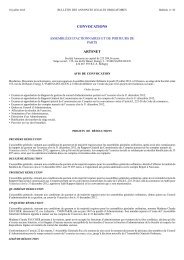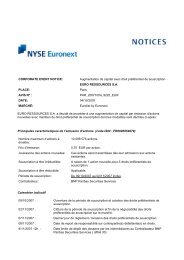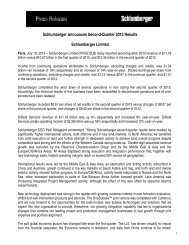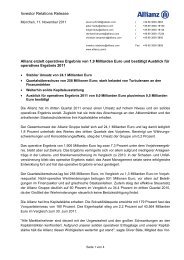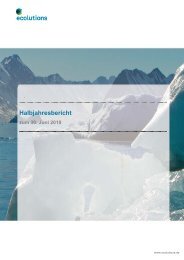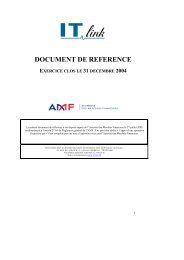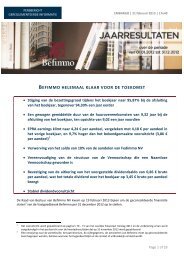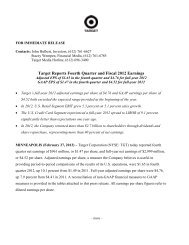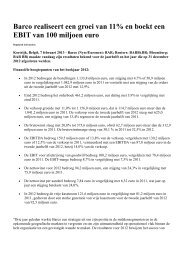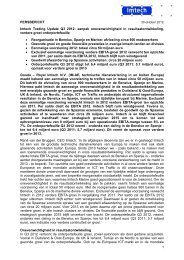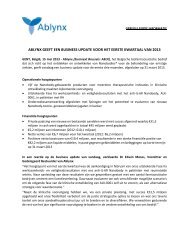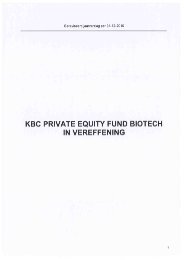Download full Annual Report and Accounts - Kingfisher
Download full Annual Report and Accounts - Kingfisher
Download full Annual Report and Accounts - Kingfisher
Create successful ePaper yourself
Turn your PDF publications into a flip-book with our unique Google optimized e-Paper software.
Kingfi sher plc<br />
<strong>Annual</strong> <strong>Report</strong><br />
<strong>and</strong> <strong>Accounts</strong><br />
2009/10<br />
(vi) Derivatives <strong>and</strong> hedge accounting<br />
Where hedge accounting is not applied, or to the extent to which it is not<br />
effective, changes in the fair value of derivatives are recognised in the income<br />
statement as they arise. Changes in the fair value of derivatives transacted as<br />
hedges of operating items <strong>and</strong> fi nancing items are recognised in operating<br />
profi t <strong>and</strong> net fi nance costs respectively.<br />
Derivatives are initially recorded at fair value on the date a derivative contract<br />
is entered into <strong>and</strong> are subsequently carried at fair value. The accounting<br />
treatment of derivatives <strong>and</strong> other fi nancial instruments classifi ed as hedges<br />
depends on their designation, which occurs at the start of the hedge<br />
relationship. The Group designates certain fi nancial instruments as:<br />
– a hedge of the fair value of an asset or liability or unrecognised fi rm<br />
commitment (‘fair value hedge’);<br />
– a hedge of a highly probable forecast transaction or fi rm commitment<br />
(‘cash fl ow hedge’); or<br />
– a hedge of a net investment in a foreign operation (‘net investment hedge’).<br />
Fair value hedges<br />
For an effective hedge of an exposure to changes in fair value, the hedged item<br />
is adjusted for changes in fair value attributable to the risk being hedged with<br />
the corresponding entry being recorded in the income statement. Gains or<br />
losses from remeasuring the corresponding hedging instrument are recognised<br />
in the same line of the income statement.<br />
Cash fl ow hedges<br />
Changes in the effective portion of the fair value of derivatives that are<br />
designated as hedges of future cash fl ows are recognised directly in equity,<br />
<strong>and</strong> the ineffective portion is recognised immediately in the income statement<br />
where relevant. If the cash fl ow hedge of a fi rm commitment or forecast<br />
transaction results in the recognition of a non-fi nancial asset or liability, then,<br />
at the time it is recognised, the associated gains or losses on the derivative<br />
that had previously been recognised in equity are included in the initial<br />
measurement of the non-fi nancial asset or liability. For hedges that result in<br />
the recognition of a fi nancial asset or liability, amounts deferred in equity are<br />
recognised in the income statement in the same period in which the hedged<br />
item affects net profi t or loss.<br />
Net investment hedges<br />
Where the Group hedges net investments in foreign operations through foreign<br />
currency borrowings, the gains or losses on the retranslation of the borrowings<br />
are recognised in equity. If the Group uses derivatives as the hedging<br />
instrument, the effective portion of the hedge is recognised in equity, with any<br />
ineffective portion being recognised in the income statement. Gains <strong>and</strong> losses<br />
accumulated in equity are recycled through the income statement on disposal<br />
of the foreign operation.<br />
In order to qualify for hedge accounting, the Group documents in advance<br />
the relationship between the item being hedged <strong>and</strong> the hedging instrument.<br />
The Group also documents <strong>and</strong> demonstrates an assessment of the<br />
relationship between the hedged item <strong>and</strong> the hedging instrument, which<br />
shows that the hedge has been <strong>and</strong> will be highly effective on an ongoing<br />
basis. The effectiveness testing is re-performed at each period end to ensure<br />
that the hedge remains highly effective.<br />
Hedge accounting is discontinued when the hedging instrument expires or is<br />
sold, terminated or exercised, or no longer qualifi es for hedge accounting. At<br />
that time, any cumulative gain or loss on the hedging instrument recognised in<br />
equity is retained in equity until the highly probable forecast transaction occurs.<br />
If a hedged transaction is no longer expected to occur, the net cumulative gain<br />
or loss recognised in equity is transferred to the income statement.<br />
Derivatives embedded in other fi nancial instruments or other host contracts<br />
are treated as separate derivatives when their risks <strong>and</strong> characteristics are not<br />
closely related to those of host contracts, <strong>and</strong> the host contracts are not carried<br />
at fair value with unrealised gains or losses reported in the income statement.<br />
65<br />
3 Critical accounting estimates <strong>and</strong> judgements<br />
The preparation of consolidated fi nancial statements under IFRS requires<br />
the Group to make estimates <strong>and</strong> assumptions that affect the application of<br />
policies <strong>and</strong> reported amounts. Estimates <strong>and</strong> judgements are continually<br />
evaluated <strong>and</strong> are based on historical experience <strong>and</strong> other factors including<br />
expectations of future events that are believed to be reasonable under the<br />
circumstances. Actual results may differ from these estimates. The estimates<br />
<strong>and</strong> assumptions which have a signifi cant risk of causing a material adjustment<br />
to the carrying amount of assets <strong>and</strong> liabilities within the next fi nancial year are<br />
discussed below.<br />
Impairment of goodwill <strong>and</strong> other assets<br />
As required, the Group applies procedures to ensure that its assets are carried<br />
at no more than their recoverable amount. The procedures, by their nature,<br />
require estimates <strong>and</strong> assumptions to be made. The most signifi cant are set<br />
out below.<br />
The Group is required, on at least an annual basis, to test whether goodwill<br />
has suffered any impairment. As part of this testing the recoverable amounts<br />
of cash generating units have been determined based on value-in-use<br />
calculations. The use of this method requires the estimation of future cash<br />
fl ows expected to arise from the continuing operation of the cash generating<br />
unit <strong>and</strong> the choice of a suitable discount rate in order to calculate the present<br />
value of the forecast cash fl ows. Actual outcomes could vary signifi cantly from<br />
these estimates. Further information on the impairment tests undertaken,<br />
including the key assumptions, is given in note 12.<br />
Property, plant <strong>and</strong> equipment are reviewed for impairment if events or changes<br />
in circumstances indicate that the carrying amount may not be recoverable.<br />
When a review for impairment is conducted, the recoverable amount of an<br />
asset or a cash generating unit is determined based on value-in-use calculations<br />
prepared on the basis of management’s assumptions <strong>and</strong> estimates.<br />
At each reporting date the Group is required to assess whether there is<br />
objective evidence that its investments in associates <strong>and</strong> joint ventures may<br />
be impaired. This requires estimates of the investments’ recoverable amounts,<br />
including present values of the Group’s share of future cash fl ows.<br />
Inventories<br />
As inventories are carried at the lower of cost <strong>and</strong> net realisable value this<br />
requires the estimation of the eventual sales price of goods to customers<br />
in the future. A high degree of judgement is applied when estimating the<br />
impact on the carrying value of inventories of factors such as slow moving<br />
items, shrinkage, damage <strong>and</strong> obsolescence. The quantity, age <strong>and</strong> condition<br />
of inventories are regularly measured <strong>and</strong> assessed as part of range reviews<br />
<strong>and</strong> inventory counts undertaken throughout the year <strong>and</strong> across the Group.<br />
Refer to note 18 for further information.<br />
Income taxes<br />
The Group is subject to income taxes in numerous jurisdictions. Signifi cant<br />
judgement is required in determining the provision for income taxes in each<br />
territory. There are many transactions <strong>and</strong> calculations for which the ultimate<br />
tax determination is uncertain during the ordinary course of business. The<br />
Group recognises liabilities for anticipated tax audit issues based on estimates<br />
of whether additional taxes will be due. Where the fi nal outcome of these<br />
matters is different from the amounts which were initially recorded, such<br />
differences will impact the income tax <strong>and</strong> deferred tax provisions in the<br />
period in which such determination is made. Refer to notes 9 <strong>and</strong> 25 for<br />
further information.



